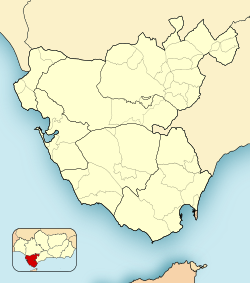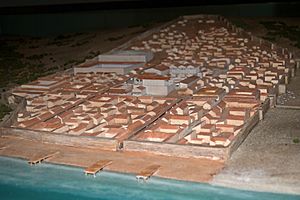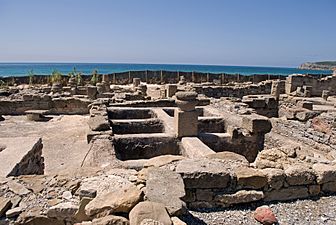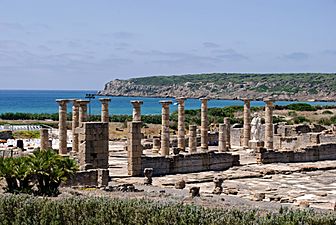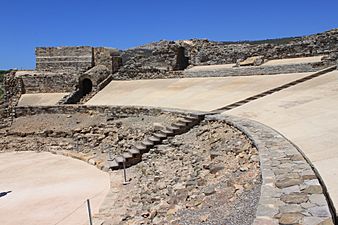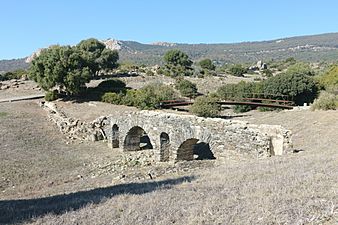Baelo Claudia facts for kids
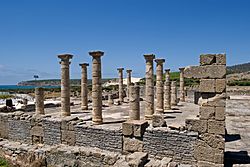
The ruins lie along the beach
|
|
| Location | Bolonia, Province of Cádiz, Andalusia, Spain |
|---|---|
| Coordinates | 36°05′23″N 05°46′29″W / 36.08972°N 5.77472°W |
| Type | Settlement |
| History | |
| Founded | End of the 2nd century BC |
| Abandoned | 6th century AD |
Baelo Claudia was an amazing ancient Roman town. It was located in a place the Romans called Hispania, which is now southern Spain. You can find its ruins about 22 kilometers (14 miles) from Tarifa, near a village called Bolonia.
This town started as a small fishing village and a busy trading spot about 2,000 years ago. It sat right on the coast, looking out over the Strait of Gibraltar. Baelo Claudia grew into a very successful town, especially during the time of Emperor Claudius.
However, over time, the town faced challenges. Earthquakes caused a lot of damage, and by the 6th century AD, people had left the town. Today, Baelo Claudia is a fantastic place to explore Roman history!
Contents
A Glimpse into Roman History
Baelo Claudia was built on the northern shore of the Strait of Gibraltar. This location was perfect for trade with North Africa. For example, it was a major port for the city of Tangier (in what was then called Mauretania Tingitana).
The town was founded around the end of the 2nd century BC. While it might have helped with some local government, its main source of wealth came from the sea. People here were experts at tuna fishing. They also made a lot of money by salting fish and producing a special fish sauce called garum. This sauce was very popular in the Roman Empire!
Baelo Claudia became so successful that Emperor Claudius gave it the special title of municipium. This meant it had more self-governance and was an important city.
Rise and Fall of Baelo Claudia
Life in Baelo Claudia was at its best between the 1st century BC and the 2nd century AD. But in the middle of the 2nd century, things started to go downhill. A big earthquake likely destroyed a large part of the town.
Later, in the 3rd century, the town faced more trouble. Groups of pirates, both Germanic and from North Africa (called Barbary pirates), attacked the town. Even though Baelo Claudia saw a small comeback later in that century, it was eventually abandoned by the 6th century.
Today, archaeologists have uncovered amazing remains of this Roman town. It's one of the most complete Roman sites in Spain and Portugal. You can see incredible buildings like the basilica (a public hall), a theater, a market, and even a temple dedicated to the Egyptian goddess Isis.
The site is located in the beautiful El Estrecho Natural Park. From here, you can even see the coast of Morocco across the strait! There's also a modern visitor's center. It has many ancient objects found at the site and helps you learn all about Baelo Claudia. The center also has parking, restrooms, a shop, and great views of the sea. If you're a citizen of the European Economic Area, you can visit for free with an ID.
Exploring the Ancient City
A person named Jorge Bonsor was very important in helping to uncover and protect this archaeological site.
The way Baelo Claudia was planned is a great example of a typical Roman city. It had two main roads:
- The decumanus maximus ran from east to west. It had the main entrances to the city on both ends.
- The cardo maximus ran from north to south. It crossed the decumanus maximus at a right angle.
Where these two main streets met, you would find the Forum. This was the main public square of the city. The pavement you see there today still has the original stone slabs from the 1st century! The Forum was an open square with covered walkways on three sides. Important public buildings were built around it.
One of these walkways led to three key buildings:
- The emperor's temple.
- The curia (where local leaders met).
- Another room used for meetings.
The biggest building at the back of the Forum was the basilica. This was like a large public hall used for many things, especially as a courthouse. On the left side of the Forum, there were small stone structures called tabernae, which were shops.
The archaeological site shows us many important parts of a Roman town:
- City Walls: Strong stone walls protected the city. They had over forty watchtowers. You can still see the main city gates: the west gate (leading to Gades) and the east gate (leading to Carteia). There was also a third gate to the north, called the Asido Gate.
- Government Buildings: These included the curia (the local senate) and the city's official records office.
- Public Square: The forum was the heart of the city.
- Courthouse: The judicial basilica was in the forum, opposite the temples. It was a large rectangular building. Inside, there was a huge statue of Emperor Trajan, over 3 meters (10 feet) tall!
- Temples: There were four temples. Three were for the main Roman gods: Jupiter, Juno, and Minerva. This triple temple layout is very rare! There was also an Iseum, a temple for the Egyptian goddess Isis. This shows how different cultures mixed in the Roman Empire.
- Theater: The largest building in Baelo Claudia was the theater. It could hold up to 2,000 people! In Roman times, all the actors were men, even for female roles. They wore masks to show different characters.
- Shops and Market: You can see the remains of tabernae (shops) and the macellum (market). The market was an enclosed area with 14 stores and a courtyard, used for selling meat and other foods.
- Bath Houses: The thermae were public bath houses, a very important part of Roman daily life.
Four aqueducts brought fresh water to the city. The industrial area still has remains of the garum-making factories. You can also see old streets, parts of the sewerage system, and more. Baelo Claudia offers one of the most complete views of a Roman city plan in Spain and Portugal. The beautiful landscape around the city makes it even more special.
In 1925, Baelo Claudia was officially recognized as a "Property of Cultural Interest" (Bien de Interés Cultural). Since 2007, there has been a museum at the site. It was designed by architect Guillermo Vázquez Consuegra.
Gallery
Visiting Baelo Claudia Today
The archaeological site is located next to a popular tourist area. This means more people are discovering its amazing history and enjoying cultural tourism. It's easy to get to the site, and visits are free.
The Junta de Andalucía (the regional government) built the new visitor reception center. They also worked on a project to improve the landscape around Bolonia beach between 2010 and 2013. The University of Cádiz continues to study the site, leading to exciting new discoveries. For example, they found the only copy of the Doryphoros of Polykleitos statue ever found in Hispania (ancient Spain).
See also
 In Spanish: Baelo Claudia para niños
In Spanish: Baelo Claudia para niños


